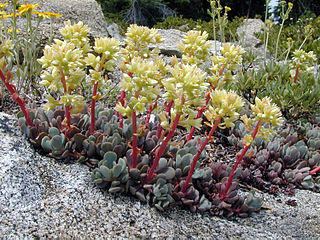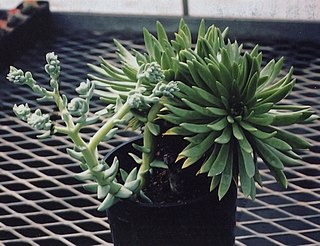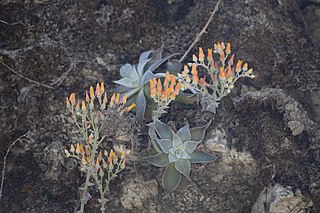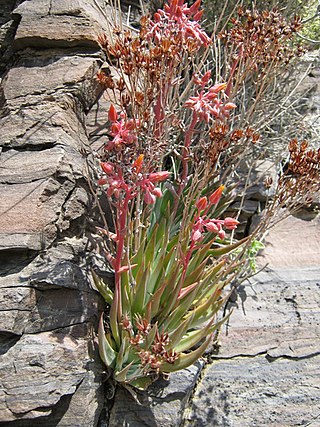
Dudleya, commonly known as liveforevers is a genus of rosette-forming succulent plants in the stonecrop family, Crassulaceae, consisting of about 68 taxa in southwestern North America and Guadalupe Island. The species come in many forms, with some large and evergreen, others geophytic and deciduous. Yet, despite their dramatic variations in appearance, most species readily hybridize. The flowers of Dudleya have parts numbered in fives, with the petals arranged in tubular, star-shaped, and bell-shaped forms and, when fruiting, are filled with tiny, ovoid-crescent-shaped seeds.

Sedum glaucophyllum, the cliff stonecrop, is a species of Sedum native to the Appalachian Mountains in the eastern United States from West Virginia, Maryland, Virginia and North Carolina.

Petrosedum rupestre, also known as reflexed stonecrop, Jenny's stonecrop, blue stonecrop, stone orpine, prick-madam and trip-madam, is a species of perennial succulent flowering plant in the family Crassulaceae, native to northern, central, and southern Europe.

Hylotelephium spectabile is a species of flowering plant in the stonecrop family Crassulaceae, native to China and Korea. Its common names include showy stonecrop, iceplant, and butterfly stonecrop.

Dudleya caespitosa is a succulent plant known by several common names, including sea lettuce, sand lettuce, and coast dudleya. It is endemic to California, where it grows along the coastline in the southern half of the state. Taxonomically, this species is a highly variable complex of polymorphic and polyploid plants, closely related to numerous neighboring species such as Dudleya farinosa, Dudleya greenei and Dudleya palmeri. It is delimited from neighboring species on an arbitrary basis of distribution and chromosome number, and may not be immediately separable from the other species it approaches.

Dudleya farinosa is a species of succulent plant in the family Crassulaceae known by several common names, including bluff lettuce, powdery liveforever, and powdery dudleya. A coastal plant of northern California and southern Oregon, it is typically found on oceanic bluffs just directly above the reach of the waves. Its appearance is characterized by lotus-like rosettes of beveled leaves, and in summer the plant erects a tall pink to red stem densely covered in foliage, topped with branches adorned with pale yellow flowers. The green or white rosettes of this plant can be seen covering stretches of rocky coast and nearby islets.

Hylotelephium cauticola, the cliff stonecrop, syn. Sedum cauticola, is a species of flowering plant in the family Crassulaceae, native to Hokkaido, Japan. Growing to 8 cm (3 in) tall by 30 cm (12 in) wide, it is a carpet-forming succulent perennial with trailing stems of pink-tinged grey-green round leaves, and purplish pink star-shaped flowers in autumn.

Sedum albomarginatum is a rare species of flowering plant in the family Crassulaceae known by the common name Feather River stonecrop. It is endemic to California where it is known from fewer than 20 occurrences along the Feather River in Plumas and Butte Counties. It grows on steep cliffs and mountain slopes in rocky serpentine substrates.
Sedum oblanceolatum is a species of flowering plant in the family Crassulaceae known by the common names oblongleaf stonecrop and Applegate stonecrop. It is native to the Klamath Mountains of southwestern Oregon and far northern California, where it grows on many types of rocky substrate, such as serpentine soils and other ultramafics. It is a succulent plant forming basal rosettes of waxy leaves. The leaves are widely lance-shaped, widest near the distal end and narrowing to rounded or notched tips. Smaller leaves occur farther up the stem. The small inflorescence grows a few centimeters tall and bears up to 50 flowers in a flat-topped array. The flowers have cream or yellowish petals up to a centimeter long.

Sedum oregonense is a species of flowering plant in the family Crassulaceae known by the common name cream stonecrop. It is native to the Klamath Ranges of southern Oregon and northern California, where it grows in rocky habitat. It is a succulent plant forming basal rosettes of leaves up to about 4 centimeters long. Smaller leaves occur farther up the stem. The leaves are green in color and waxy in texture. The inflorescence is an erect, wide open array of many flowers. The flowers have yellow petals with red-tinged or white-speckled undersides.
Sedum moraniii is a rare species of flowering plant in the family Crassulaceae known by the common name Rogue River stonecrop. It is endemic to Oregon in the United States, where it only grows in Josephine County next to the Rogue River.

Sedum dasyphyllum, also named Sedum burnatii and commonly known as Corsican stonecrop or thick-leaved stonecrop, is a low-growing succulent flowering plant of the genus Sedum in the family Crassulaceae.

Dudleya guadalupensis is a very rare species of succulent perennial plant in the family Crassulaceae commonly known as the Guadalupe liveforever. It is a rosette-forming leaf succulent, with foliage that is variously colored light green, green, and a waxy white. It is characterized by dense leaves that fold over the center in dormancy, a curving, sinuous flower stalk, and white, cup-shaped flowers. It is endemic to the rocks and islets off of Guadalupe Island, an isolated volcanic island in the Pacific Ocean located 241 kilometers off of the coast of Baja California.
Dudleya formosa, known by the common name La Misión liveforever, is a species of perennial succulent plant endemic to the Guadalupe Valley in Baja California. It is characterized by bright green leaves, red floral stems, and pink flowers.

Dudleya saxosa subsp. collomiae, known by the common name Gila County liveforever, is a subspecies of perennial succulent plant within the genus Dudleya native to central Arizona. It is characterized by showy bright-yellow flowers on an upright inflorescence colored pink, red or orange. The leaves are green or covered in a white, powdery wax. This species is found growing in rocky slopes, canyons, and crevices, and often on Sonoran Desert sky islands.

Dudleya cymosasubsp. pumila, most commonly known as the low canyon dudleya, chalky canyon dudleya or California live-forever, is a species of perennial succulent plant. It has diamond to spoon shaped leaves, sometimes coated with a fine white powder, and in May through July, bright red, orange or yellow flowers adorn the short inflorescence. A leaf succulent primarily found growing in rocky cliffs and slopes, it is endemic to California, and grows in the Transverse Ranges and South Coast Ranges, with some outlying populations. A variable plant, in some localities it is difficult to distinguish from other plants in the genus.

Dudleya saxosasubsp. aloides is a species of perennial succulent plant in the family Crassulaceae known by the common names desert dudleya or desert savior. It is a rosette-forming species widely distributed throughout the Peninsular Ranges and desert mountains of California in the United States. It is characterized by bright-yellow or greenish-yellow flowers, and can be found in shaded crevices and slopes. Plants in western half of the range may grade into Dudleya lanceolata.

Dudleya cymosasubsp. cymosa is a species of succulent perennial plant in the family Crassulaceae native to California. It is the autonymous subspecies for Dudleya cymosa, and is known by the common name canyon liveforever. It is native to the California Coast Ranges, the Sierra Nevada and the Santa Monica Mountains. It is characterized by bright-yellow, orange or red flowers and broad, wide leaves. This plant is commonly found growing on rocky outcrops, talus slopes, and in shaded canyons.

Dudleya saxosasubsp. saxosa is a species of succulent perennial plant endemic only to the western Panamint Range of California. It is known commonly as the Panamint liveforever or Panamint dudleya. It is found on north-facing, granitic or limestone slopes and grows up to 20 cm wide. It is characterized by bright yellow, red tinged flowers, which bloom from May to June.

Sedum album subsp. rupimelitense is a plant subspecies belonging to the Crassulaceae family. It is an endemic taxon in the Maltese Islands and is found growing on sea cliffs and rock faces. This taxon is often referred to as the Maltese stonecrop due to its growth on rocky outcrops.



















